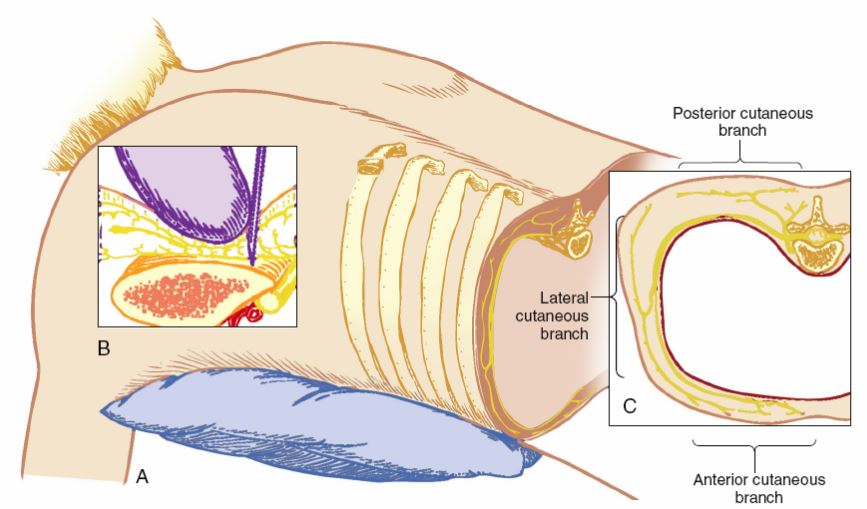|
Intercostal blocks provide good analgesia for fractured ribs, neuralgia, breast surgery and thoracic surgery.
Anatomy
Intercostal nerves run along the subcostal groove with the intercostal vessels. They lie deep to the internal intercostal muscles. Near the mid-axillary line, intercostal nerves divide into lateral and anterior cutaneous branches.
- Anterior cutaneous branches continue in the subcostal groove and supply a small area on the chest.
- Lateral cutaneous branches pass through the intercostal muscles, dividing into anterior and posterior divisions to supply most of the thorax and abdominal wall. To ensure blockade of lateral branches, LA infiltration should be done posterior to the mid-axillary line.
Complications
LA toxicity (systemic absorption) is a significant risk.
Less commonly: failure (1%), clinically significant pneumothorax (<0.1%), haemothorax (rare), intercostal neuralgia (rare), total spinal anaesthesia (rare).
Technique

Source: Anesthwiki
- Position patient prone or lateral, with arm abducted and flexed to retract scapula
- Palpate appropriate vertebral level(s)
- Mark an insertion point 40-80mm lateral to the midline, just lateral to paraspinal muscles, over the caudal end of the rib angle
- Retract skin cranially and introduce needle down to bone
- Relax skin pressure and with about 20deg of cranial angulation of needle, advance needle 3mm below rib contact point. Needle should not be advanced >8mm deep to bone contact. As intercostal vessels are close, careful aspiration to avoid intravascular injection.
- Inject 3-5ml of LA with adrenaline. 4-8h of analgesia can be expected with 0.5% levobupivacaine or ropivacaine. Adrenaline should be added to limit absorption, as this block is associated with high blood levels of LA.
- Although the intercostal space is continuous with the paravertebral space, spread to adjacent intercostal nerves is minimal. If >4 intercostal nerves need to be blocked, an alternative technique should be chosen or catheter inserted.
References
Warman P, Conn D, Nicholls B, Wilkinson D. Regional Anaesthesia, Stimulation, and Ultrasound Techniques. Oxford Specialist Handbooks in Anaesthesia.
Author:
Ms Yanyu Tan
| Speciality:
Anaesthetics/ICU
| Date Added:
09/11/2018
|